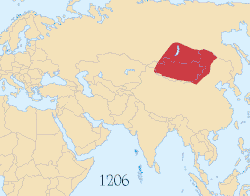Mongolrīce
Þæt Mongolrīce (Ikh Mongol Uls) beƿreag miclne Asie dæl in þæm 13. and 14. gearhundum. Hit ƿæs þæt mǣste eallætgadre landrīce in eallum stǣre.[1]

Of hiera earde in Middelasie ƿongum staðoleden þā Mongolas hiera rīce oððæt hit brǣdde fram Middeleuropan oþ þæm Iapanmere, and brǣdde norþƿeard in Siberie, ēastƿeard and sūþƿeard in þone Indiscan underƿorulddæl, Indocīna, and þā Persisca ƿong, and ƿestƿeard in Russland and Arabealand.
Þis rīce geānede nomadic mægþu of Mongolland under Genghis Khan cynedōm, se ƿæs abanned rica ofer eallum Mongolum in 1206. His rīce ƿeax snille under his rīce and under his ierfum, þā sendedon invasions in ælcum direction.[2][3][4][5][6][7] Þæt Mongolrīce oferbeƿreag Asie mǣstan dæl and ƿæs hlenc þære ēasternan ƿorulde mid þære ƿesterne ƿorulde mid Mongolgriþ þærunder cƿōmon mangere and searƿas, fēoh, and onþenc ofer Eurasie.[8][9]
Frūman
adihtan- ↑ Morgan. The Mongols. p. 5.
- ↑ Diamond. Guns, Germs, and Steel. p. 367.
- ↑ The Mongols and Russia, by George Vernadsky
- ↑ The Mongol World Empire, 1206–1370, by John Andrew Boyle
- ↑ The History of China, by David Curtis Wright. p. 84.
- ↑ The Early Civilization of China, by Yong Yap Cotterell, Arthur Cotterell. p. 223.
- ↑ Mongols and Mamluks: The Mamluk-Ilkhanid War, 1260–1281 by Reuven Amitai-Preiss
- ↑ Gregory G.Guzman "Were the barbarians a negative or positive factor in ancient and medieval history?", The Historian 50 (1988), 568-70.
- ↑ Allsen. Culture and Conquest. p. 211.